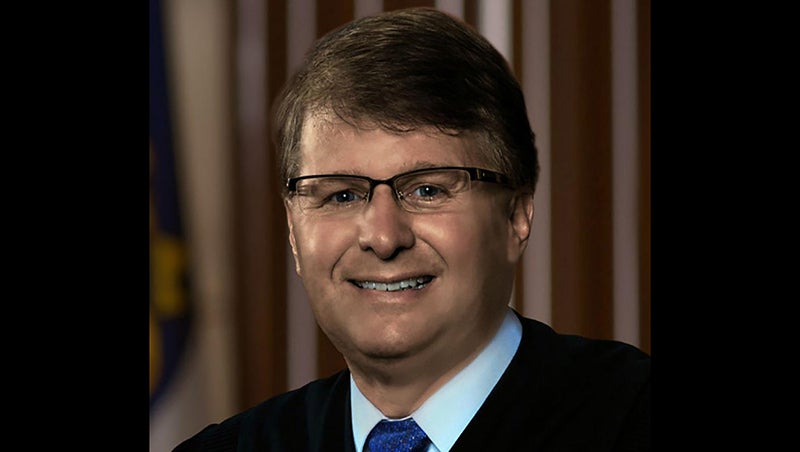Op-Ed: A leak in the court’s foundation
Published 7:05 am Monday, May 16, 2022

- Chief Justice Mark Martin (ret.)
|
Getting your Trinity Audio player ready...
|
By Chief Justice Mark Martin (ret.)
Not surprisingly, the leak of a draft opinion in Dobbs v. Jackson Women’s Health Organization ignited a firestorm of protests and media coverage. Most of the media coverage – and all of the protests – have focused on the reasoning and outcome of the draft. But there’s another aspect to the story: the apparent erosion of confidentiality and trust at the Supreme Court.
To understand why that matters, let’s start at the beginning. The Constitution divides power among three branches. Congress writes the laws. The President executes the laws. And the judiciary interprets the laws. The first two branches are designed to be responsive to political considerations.
But the judiciary is supposed to be different. Federal judges are insulated from political pressure through life tenure. A federal judge’s role is to interpret and apply the constitution and laws. During his confirmation hearings, Chief Justice John Roberts famously compared judging to umpiring a baseball game – his job, as he saw it, was to call balls and strikes.
Of course, the job isn’t quite that simple. Parsing federal statutes can be challenging. An ambiguous word or awkward phrase can spark intense debate over how a statute should operate. Constitutional interpretation is typically even more taxing. The Constitution is often worded broadly – as we law professors are fond of saying, its provisions are “open-textured.” There are varying theories of constitutional interpretation that result in starkly different conclusions about what the text means. And you might be surprised how often two judges using the same interpretive methods arrive at very different results.
Figuring all this out requires meticulous research and careful drafting – a process that depends heavily on institutional collaboration. A majority can agree on an outcome, but that’s only one piece of the puzzle. The outcome applies only to the case at bar. It’s the reasoning that affects future cases. Appellate justices must take care to get the reasoning right.
The process looks something like this. The parties brief the court on the issues in the case, and they present their best arguments for why they should prevail. The members of the court deliberate in private and tentatively agree on an outcome.
That outcome isn’t final – it’s a starting point. One justice drafts an opinion that is circulated among the rest of the court. Other justices provide feedback. They might think there’s a better explanation for an issue. They don’t like the way the opinion frames another issue. The justice who drafted the opinion receives feedback from those who agree and those who disagree, and then works to improve the draft. When there is still disagreement, justices are free to issue separate opinions that disagree with the reasoning or outcome of the opinion.
This collaborative process sharpens the court’s reasoning. It leads to a better final product. But the level of openness it requires leaves justices vulnerable. What if there is a breach of confidentiality? Perhaps an error in a draft is released to the public. As a former judge, I can say with confidence: we’re all human. We all make mistakes. We can miss key details. So, at an appellate court, we rely heavily on our colleagues, our clerks, and the court’s staff to improve draft opinions. That level of openness and vulnerability requires trust. And trust requires confidentiality.
Being a justice is a challenging job. The stakes in many cases are high. The issues are often complicated. The pressure to arrive at the “correct” answer is palpable. The internal deliberative process is fluid. Sometimes, it’s downright chaotic. As justices reason through the issues and engage in internal debate, their rationales can change. Votes can change. And when votes change, outcomes can change. Confidentiality allows for internal deliberations to occur without undue pressure from the parties or the public. Remember, judges and justices aren’t trying to reach a popular result. They’re trying to arrive at the correct legal result.
Confidentiality makes that possible. That’s why Chief Justice Roberts – a man famous for his measured responses – has had particularly harsh words for the leaker. In public statements, the Chief Justice has called the leak a “betrayal,” “foolish,” and “absolutely appalling.” A leak of a draft opinion – particularly in a case like Dobbs – corrupts the deliberative process and erodes trust.
While the public responds to the substance of the leaked draft, the Supreme Court must remediate an institutional injury – the loss of trust and confidence so essential to a properly functioning judicial body. Let’s hope they can do so.
Chief Justice Mark Martin (ret.) served as chief justice of the Supreme Court of North Carolina. He is dean and professor at Regent Law School.
READ ABOUT NEWS AND EVENTS HERE.





